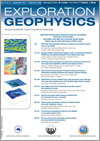
Exploration Geophysics
Volume 47 Number 3 2016
ASEG-PESA 24th International Geophysical Conference and Exhibition: Special Issue on Case Studies
EGv47n3_EDASEG-PESA 24th International Geophysical Conference and Exhibition: Special Issue on Case Studies
EG15088Helicopter AFMAG (ZTEM) EM and magnetic results over sedimentary exhalative (SEDEX) lead-zinc deposits at Howard’s Pass in Selwyn Basin, Yukon
In 2008, a ZTEM natural field EM and magnetic survey was flown over the world-class, >250 Mt SEDEX deposits at Howard’s Pass in the Selwyn Basin, Yukon. The AEM data provide insights into regional structures and intrusions. They also reveal a correlation between enhanced conductivity along strike and the clustering of deposits at Howard’s Pass.
EG15080VTEM airborne EM, aeromagnetic and gamma-ray spectrometric data over the Cerro Quema high sulphidation epithermal gold deposits, Panama
In March 2012, a helicopter-borne VTEM survey was flown over the Cerro Quema high sulphidation (HS) epithermal gold deposits. The geophysical data obtained were analysed for geophysical signatures characteristic of HS epithermal gold deposits. The success of this survey points to the applicability of EM-Mag-Spec surveys for the exploration of similar deposits.
EG15089Passive airborne EM and ground IP\resistivity results over the Romero intermediate sulphidation epithermal gold deposits, Dominican Republic
The Romero gold-copper-zinc-silver deposits in the Dominican Republic are of the intermediate sulphidation epithermal type. Ground IP\resistivity results are compared to ZTEM passive airborne electromagnetics over the deposit region. The ZTEM results show good correlation with ground IP\resistivity results and identify a previously unknown deep (>500 m) continuity between the Romero deposits.
EG15105Identification of massive sulphide targets using the galvanic source EM signal from a sub-audio magnetic survey at the Far South project, Western Australia
Data from the Far South project were acquired using a sub-audio magnetic (SAM) survey, set up in galvanic configuration. The galvanic source electromagnetic (GSEM) data were used to identify conductive responses. Modelling of the GSEM responses was attempted with some success, showing this method to be an effective reconnaissance tool.
EG15090New insights into the North Taranaki Basin from New Zealand’s first broadband 3D survey
The North Taranaki Basin contains widespread (2D) seismic coverage and numerous wells. The basin hydrocarbon potential remains unproven. An active petroleum system is conï¬rmed by hydrocarbon shows and non-commercial oil and gas discoveries (Karewa-1 and Kora-1). 3D seismic interpretation and amplitude-versus-offset (AVO) analysis support the renewed potential of the basin.
EG16009Enhanced 3D prestack depth imaging of broadband data from the South China Sea: a case study
We present a study of prestack depth imaging for data from the South China Sea, including complex geologies, using an enhanced work flow. The imaging results and data analysis prove that the enhanced work flow consisting of cutting edge technologies is effective when complex geologies are present.
EG15075Airborne gravity gradiometer surveying of petroleum systems under Lake Tanganyika, Tanzania
An airborne gravity gradiometry and high-resolution aeromagnetic survey conducted in Lake Tanganyika within the East African Rift System has been interpreted to demonstrate sedimentary sequences and structures prospective for petroleum. Numerous play types analogous to the Lake Albert oil discoveries further north in Uganda are revealed by further surveys.
EG15094The discovery and geophysical response of the Atlántida Cu–Au porphyry deposit, Chile
We provide detailed geophysical characterisation of porphyry style Cu-Au mineralisation of the Atlántida project, located under 25–80 m post-mineral gravels of the Atacama Desert, Northern Chile. Clear geological controls on the geophysical signatures of the deposit are resolved via the use of petrophysical studies and incorporation of drill testing results.
EG15096Discovery of the Eureka volcanogenic massive sulphide lens using downhole electromagnetics
The Eureka massive sulphide lens forms part of the Stockman Project in north-east Victoria. Eureka was discovered in early 2013, combining the interpretation of two subtle downhole electromagnetic anomalies with a robust geological model, with additional support from short-wave infrared and structural modelling.

